Starting the Year as I Mean to Go On?
The houseguests have gone home, the Christmas tree is coming down tomorrow, and it’s darned cold. I’m feeling stuck in a rut in my career, the blog, and so many other areas of life. It’s hard not to think of 2017 as a huge stretch of emptiness with very few bright spots. All I want to do is sit around in my new fuzzy bathrobe and read under the cat. Luckily, I’ve had some great books to accompany me through the Christmas period and have finished five so far this year.
I thought I’d continue the habit of writing two-sentence reviews (or maybe no more than three), except when I’m writing proper full-length reviews on assignment or for blog tours or other websites. Granted, they’re usually long and multi-part sentences, and this isn’t actually a time-saving trick – as Blaise Pascal once said, “I’m sorry I wrote you such a long letter; I didn’t have time to write a short one” – but it feels like good discipline.
So here’s some mini-reviews of what I’ve been reading in late December and early January:
The Dark Flood Rises, Margaret Drabble
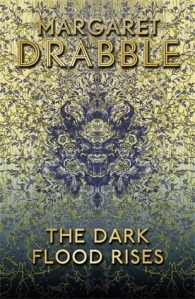 The “dark flood” is D.H. Lawrence’s metaphor for death, and here it corresponds to busy seventy-something Fran’s obsession with last words, obituaries and the search for the good death as many of her friends and acquaintances succumb – but also to literal flooding in the west of England and (dubious, this) to mass immigration of Asians and Africans into Europe. This is my favorite of the five Drabble books that I’ve read – it’s closest in style and tone to her sister A.S. Byatt as well as to Tessa Hadley, and the themes of old age and life’s randomness are strong – even though there seem to be too many characters and the Canary Islands subplot mostly feels like an unnecessary distraction. (Public library)
The “dark flood” is D.H. Lawrence’s metaphor for death, and here it corresponds to busy seventy-something Fran’s obsession with last words, obituaries and the search for the good death as many of her friends and acquaintances succumb – but also to literal flooding in the west of England and (dubious, this) to mass immigration of Asians and Africans into Europe. This is my favorite of the five Drabble books that I’ve read – it’s closest in style and tone to her sister A.S. Byatt as well as to Tessa Hadley, and the themes of old age and life’s randomness are strong – even though there seem to be too many characters and the Canary Islands subplot mostly feels like an unnecessary distraction. (Public library) 
Hogfather, Terry Pratchett
 In Discworld belief causes imagined beings to exist, so when a devious plot to control children’s minds results in a dearth of belief in the Hogfather, the Fat Man temporarily disappears and Death has to fill in for him on this Hogswatch night. I laughed aloud a few times while reading this clever Christmas parody, but I had a bit of trouble following the plot and grasping who all the characters were given that this was my first Discworld book; in general I’d say that Pratchett is another example of British humor that I don’t entirely appreciate (along with Monty Python and Douglas Adams) – he’s my husband’s favorite, but I doubt I’ll try another of his books. (Own copy)
In Discworld belief causes imagined beings to exist, so when a devious plot to control children’s minds results in a dearth of belief in the Hogfather, the Fat Man temporarily disappears and Death has to fill in for him on this Hogswatch night. I laughed aloud a few times while reading this clever Christmas parody, but I had a bit of trouble following the plot and grasping who all the characters were given that this was my first Discworld book; in general I’d say that Pratchett is another example of British humor that I don’t entirely appreciate (along with Monty Python and Douglas Adams) – he’s my husband’s favorite, but I doubt I’ll try another of his books. (Own copy) 
Love of Country: A Hebridean Journey, Madeleine Bunting
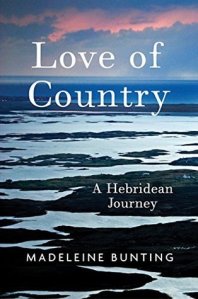 In a reprise of childhood holidays that inevitably headed northwest, Bunting takes a series of journeys around the Hebrides and weaves together her contemporary travels with the religion, folklore and history of this Scottish island chain, an often sad litany of the Gaels’ poverty and displacement that culminated with the brutal Clearances. Rather than giving an exhaustive survey, she chooses seven islands to focus on and tells stories of unexpected connections – Orwell’s stay on Jura, Lord Leverhulme’s (he of Port Sunlight and Unilever) purchase of Lewis, and Bonnie Prince Charlie’s landing on Eriskay – as she asks how geography influences history and what it truly means to belong to a place. (Public library)
In a reprise of childhood holidays that inevitably headed northwest, Bunting takes a series of journeys around the Hebrides and weaves together her contemporary travels with the religion, folklore and history of this Scottish island chain, an often sad litany of the Gaels’ poverty and displacement that culminated with the brutal Clearances. Rather than giving an exhaustive survey, she chooses seven islands to focus on and tells stories of unexpected connections – Orwell’s stay on Jura, Lord Leverhulme’s (he of Port Sunlight and Unilever) purchase of Lewis, and Bonnie Prince Charlie’s landing on Eriskay – as she asks how geography influences history and what it truly means to belong to a place. (Public library) 
Cobwebs and Cream Teas: A Year in the Life of a National Trust House, Mary Mackie
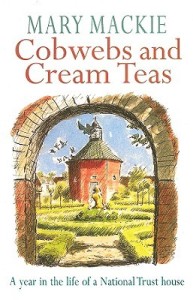 Mackie’s husband was Houseman and then Administrator at Felbrigg Hall in Norfolk in the 1980s – live-in roles that demanded a wide range of skills and much more commitment than the usual 9 to 5 (when he borrowed a pedometer he learned that he walked 15 miles in the average day, without leaving the house!). Her memoir of their first year at Felbrigg proceeds chronologically, from the intense cleaning and renovations of the winter closed season through to the following Christmas’ festivities, and takes in along the way plenty of mishaps and visitor oddities. It will delight anyone who’d like a behind-the-scenes look at the life of a historic home. (Own copy)
Mackie’s husband was Houseman and then Administrator at Felbrigg Hall in Norfolk in the 1980s – live-in roles that demanded a wide range of skills and much more commitment than the usual 9 to 5 (when he borrowed a pedometer he learned that he walked 15 miles in the average day, without leaving the house!). Her memoir of their first year at Felbrigg proceeds chronologically, from the intense cleaning and renovations of the winter closed season through to the following Christmas’ festivities, and takes in along the way plenty of mishaps and visitor oddities. It will delight anyone who’d like a behind-the-scenes look at the life of a historic home. (Own copy) 
The Bridge Ladies: A Memoir, Betsy Lerner
 When life unexpectedly took the middle-aged Lerner back to her hometown of New Haven, Connecticut, she spent several years sitting in on her mother’s weekly bridge games to learn more about these five Jewish octogenarians who have been friends for 50 years and despite their old-fashioned reserve have seen each other through the loss of careers, health, husbands and children. Although Lerner also took bridge lessons herself, this is less about the game and more about her ever-testy relationship with her mother (starting with her rebellious teenage years), the ageing process, and the ways that women of different generations relate to their family and friends. It wouldn’t be exaggerating to say that every mother and daughter should read this; I plan to shove it in my mother’s and sister’s hands the next time I’m in the States. (Own copy)
When life unexpectedly took the middle-aged Lerner back to her hometown of New Haven, Connecticut, she spent several years sitting in on her mother’s weekly bridge games to learn more about these five Jewish octogenarians who have been friends for 50 years and despite their old-fashioned reserve have seen each other through the loss of careers, health, husbands and children. Although Lerner also took bridge lessons herself, this is less about the game and more about her ever-testy relationship with her mother (starting with her rebellious teenage years), the ageing process, and the ways that women of different generations relate to their family and friends. It wouldn’t be exaggerating to say that every mother and daughter should read this; I plan to shove it in my mother’s and sister’s hands the next time I’m in the States. (Own copy) ![]()
Waiting on the Word, Malcolm Guite
 Guite chooses well-known poems (by Christina Rossetti, John Donne, Alfred Lord Tennyson, Samuel Taylor Coleridge et al.) as well as more obscure contemporary ones as daily devotional reading between the start of Advent and Epiphany; I especially liked his sonnet sequence in response to the seven “O Antiphons.” His commentary is learned and insightful, and even if at times I thought he goes into too much in-depth analysis rather than letting the poems speak for themselves, this remains a very good companion to the Christmas season for any poetry lover. (E-book from NetGalley)
Guite chooses well-known poems (by Christina Rossetti, John Donne, Alfred Lord Tennyson, Samuel Taylor Coleridge et al.) as well as more obscure contemporary ones as daily devotional reading between the start of Advent and Epiphany; I especially liked his sonnet sequence in response to the seven “O Antiphons.” His commentary is learned and insightful, and even if at times I thought he goes into too much in-depth analysis rather than letting the poems speak for themselves, this remains a very good companion to the Christmas season for any poetry lover. (E-book from NetGalley) 
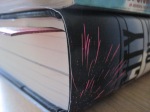 I started too many books over Christmas and have sort of put six of them on hold – including Titus Groan, which I’m thinking of quitting (it takes over 50 pages for one servant to tell another that the master has had a son?!), and City on Fire, which is wonderful but dispiritingly long: even after two good sessions with it in the days after Christmas, I’ve barely made a dent.
I started too many books over Christmas and have sort of put six of them on hold – including Titus Groan, which I’m thinking of quitting (it takes over 50 pages for one servant to tell another that the master has had a son?!), and City on Fire, which is wonderful but dispiritingly long: even after two good sessions with it in the days after Christmas, I’ve barely made a dent.

Stack on left = on hold (the book on top is Under the Greenwood Tree); standing up at right = books I’m actually reading.
However, the three books that I am actively reading I’m loving: To Say Nothing of the Dog by Connie Willis is an uproarious blend of time travel science fiction and Victorian pastiche (university library), Pachinko by Min Jin Lee is a compulsive historical saga set in Korea (ARC from NetGalley), and the memoir Birds Art Life by Kyo Maclear has been compared to H Is for Hawk in the way she turns to birdwatching to deal with depression (e-book from Edelweiss). I also will be unlikely to resist my e-galley of the latest Anne Lamott book, Hallelujah Anyway (forthcoming in April, ARC from Edelweiss), for much longer.
Meanwhile, in post-holiday charity shopping I scored six books for £1.90: one’s been tucked away as a present for later in the year; the Ozeki I’ve already read, but it’s a favorite so I’m glad to own it; and the rest are new to me. I look forward to trying Han Kang; Anne Tyler is a reliable choice for a cozy read; and the Hobbs sounds like a wonderful Victorian-set novel.
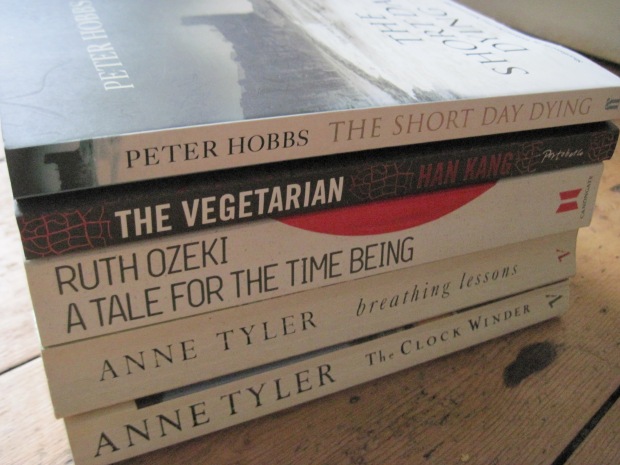
All in all, I seem to be starting my year in books as I mean to go on: reading a ton; making sure I review most or all of the books, even if I write just a few sentences; maintaining a balance between my own books, library books, and recent or advance NetGalley/Edelweiss reads; and failing to restrain myself from buying more.
Now if I could just work on my general attitude…
How’s the reading year starting off for you?
Five Books about Cats
I always used to be more of a dog person than a cat person, even though we had both while I was growing up, but now I’m a dedicated cat owner and have tried out some related reading. You’ll notice I don’t rate any of these five books about cats particularly highly, whereas there have been a number of dog books I’ve given 4 stars (Dog Years by Mark Doty, Ordinary Dogs by Eileen Battersby, A Dog’s Life by Peter Mayle; even books that aren’t necessarily about dogs but reference life with them, like A Three Dog Life by Abigail Thomas and Travels with Charley by John Steinbeck). What’s with that? Maybe dog lovers don’t have to worry so much about striking a balance between a pet’s standoffishness and affection. Maybe dogs play a larger role in everyday human life and leave a more gaping hole when they shuffle off the canine coil. Still, I enjoyed aspects of or specific passages from each of the following.
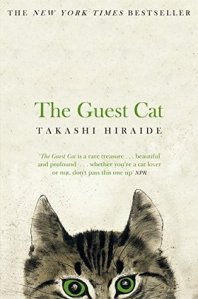 The Guest Cat by Takashi Hiraide
The Guest Cat by Takashi Hiraide
As a cat-loving freelance writer who aspires to read more literature in translation, I thought from the blurb that this book could not be more perfect for me. I bought it in a charity shop one afternoon and started reading right away. It’s only 140 pages, so I finished within 24 hours, but felt at a distance from the story the whole time. Part of it might be the translation – the translator’s notes at the end explain some useful context about the late 1980s setting, but also conflate the narrator and the author in such a way that the book seems like an artless memoir rather than a novella. But the more basic problem for me is that there’s simply not enough about the cat. There’s plenty of architectural detail about the guesthouse the narrator and his wife rent on the grounds of a mansion, plenty of economic detail about the housing market…but the cat just doesn’t make enough of an impression. I’m at a bit of a loss to explain why this has been such a bestseller. Quite the disappointment.
My rating: 
 The Fur Person by May Sarton
The Fur Person by May Sarton
I’m a huge fan of May Sarton’s journals – in which various cats play supporting roles – so for a while I’d been hoping to come across a copy of this little novelty book from 1957, a childish fable about a tomcat who transforms from a malnourished Cat-About-Town to a spoiled Gentleman Cat. Luckily I managed to find a copy of this one plus the Lessing (see below) in the Nature section at Book Thing of Baltimore. In a preface to the 1978 edition Sarton reveals that Tom Jones was, indeed, a real cat, a stray she and her partner Judy Matlack adopted when they lived in Cambridge, Massachusetts. Wonderful coincidence: when they were on sabbatical in the early 1950s, they sublet the place to the Nabokovs, who looked after Tom while they were away!
 I found this a bit lightweight overall, and the whole idea of a ‘fur person’ is a little strange – don’t we love cats precisely because they’re not people? Still, I enjoyed the proud cat’s Ten Commandments (e.g. “II. A Gentleman Cat allows no constraint of his person … III. A Gentleman Cat does not mew except in extremity”) and spotted my own domestic situation in this description: “while she [‘Gentle Voice’ = Judy] was away the other housekeeper [= Sarton] was sometimes quite absent-minded and even forgot his lunch once or twice because she sat for hours and hours in front of a typewriter, tapping out messages with her fingers.” The black-and-white illustrations by David Canright are a highlight.
I found this a bit lightweight overall, and the whole idea of a ‘fur person’ is a little strange – don’t we love cats precisely because they’re not people? Still, I enjoyed the proud cat’s Ten Commandments (e.g. “II. A Gentleman Cat allows no constraint of his person … III. A Gentleman Cat does not mew except in extremity”) and spotted my own domestic situation in this description: “while she [‘Gentle Voice’ = Judy] was away the other housekeeper [= Sarton] was sometimes quite absent-minded and even forgot his lunch once or twice because she sat for hours and hours in front of a typewriter, tapping out messages with her fingers.” The black-and-white illustrations by David Canright are a highlight.
My rating: 
 Particularly Cats…And Rufus by Doris Lessing
Particularly Cats…And Rufus by Doris Lessing
A book about cats that I would almost hesitate to recommend to cat lovers: it contains many a scene of kitty carnage, as well as some unenlightened resistance to spaying and neutering. Lessing grew up on a farm in Zimbabwe that was at one point overrun with about 40 cats. Her mother went away, expecting her father to have ‘taken care of them’ by the time she got back. He tried chloroform to start with, but it was too slow and ineffective; in the end he rounded them all up in a room and got out his WWI revolver. And that’s not the end of it; even into her adulthood in England Lessing balked at taking female cats in for surgery so would find occasionally herself saddled with unwanted litters of kittens that they decided had to be drowned. It’s really a remarkably unsentimental record of her dealings with cats.
That’s not to say there weren’t some cats she willingly and lovingly kept as pets, particularly a pair of rival females known simply as “black cat” and “grey cat,” and later a stray named Rufus who adopted her. But even with cherished felines she comes across as tough: “Anyway, she had to be killed and I decided that to keep cats in London was a mistake” or “I smacked grey cat” for bullying the black one. The very fact of not giving the pair names certainly quashes any notion of her as some cuddly cat lady. All the same, she was a dutiful nurse when black cat and Rufus fell ill. The book ends on a repentant note: “Knowing cats, a lifetime of cats, what is left is a sediment of sorrow quite different from that due to humans: compounded of pain for their helplessness, of guilt on behalf of us all.”
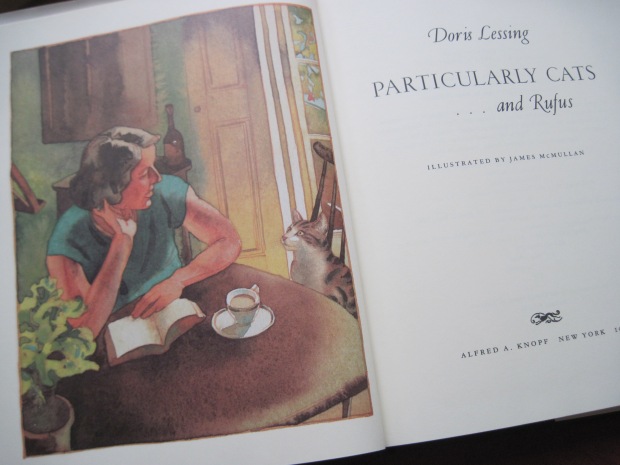
My favorite thing about the book is the watercolor illustrations by James McMullan.
My rating: 
 The Unadulterated Cat: A Campaign for Real Cats by Terry Pratchett
The Unadulterated Cat: A Campaign for Real Cats by Terry Pratchett
Like Douglas Adams or Monty Python, Terry Pratchett is, alas, a representative of the kind of British humor I just don’t get. But I rather enjoyed this small novelty book (bought for my husband for Christmas) all the same. For Pratchett, a “Real” cat is a non-pampered, tough-as-nails outdoor creature that hunts and generally does its own thing but also knows how to wrap its human servants around its paws. I like his idea of “cat chess” as a neighborhood-wide feline game of strategy, moving between carefully selected vantage points to keep an eye on the whole road yet avoid confrontation with other cats. It’s certainly true on our street. And this is quite a good summary of what cats do and why we put up with them:
What other animal gets fed, not because it’s useful, or guards the house, or sings, but because when it does get fed it looks pleased? And purrs. The purr is very important. It’s the purr that makes up for the Things Under the Bed, the occasional pungency, the 4 a.m. yowl.
My rating: 
 On Cats by Charles Bukowski
On Cats by Charles Bukowski
“In my next life I want to be a cat. To sleep 20 hours a day and wait to be fed. To sit around licking my ass.” I’d never read anything else by Bukowski, so I wasn’t sure quite what to expect from this book, which is mostly composed of previously unpublished poems and short prose pieces about the author’s multiple cats. The tone is an odd mixture of gruff and sentimental. Make no mistake: his cats were all Real cats, in line with the Pratchett model. A white Manx cat, for instance, had been shot, run over, and had his tail cut off. Another was named Butch Van Gogh Artaud Bukowski. You wouldn’t mess with a cat with a macho name like that, would you? My favorite passage is from “War Surplus,” about an exchange he and his wife had with a store clerk:
“what will the cats do if there is an explosion?”
“lady, cats are different than we are, they are of a lower order.”
“I think cats are better than we are,” I said.
the clerk looked at me. “we don’t have gas masks for cats.”
My rating: 



